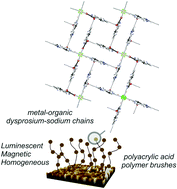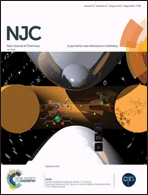Covalent immobilization of dysprosium-based metal–organic chains on silicon-based polymer brush surfaces†
Abstract
We report on a process for immobilizing metal–organic chains constructed of dysprosium and sodium ions based on 5-aminopyridine-2-carboxylic acid, onto silicon-based surfaces coated with poly(acrylic acid) (PAA) polymer brushes. Atomic force microscopy (AFM) and fluorescence microscopy were used to study the film morphology before and after the deposition of the 1D metallo-organic polymer. The covalent linkage of the dysprosium complex is also confirmed using X-ray photoelectron spectroscopy (XPS) and energy-dispersive X-ray spectroscopy (SEM-EDS) analysis. Using magnetic force microscopy (MFM) we particularly addressed the magnetic properties of the grafted metal–organic structure. These results suggest a simple and effective method for incorporation of such molecules onto nanometric surfaces.



 Please wait while we load your content...
Please wait while we load your content...